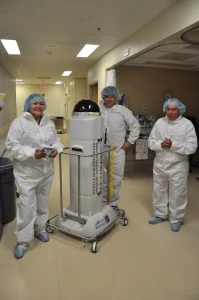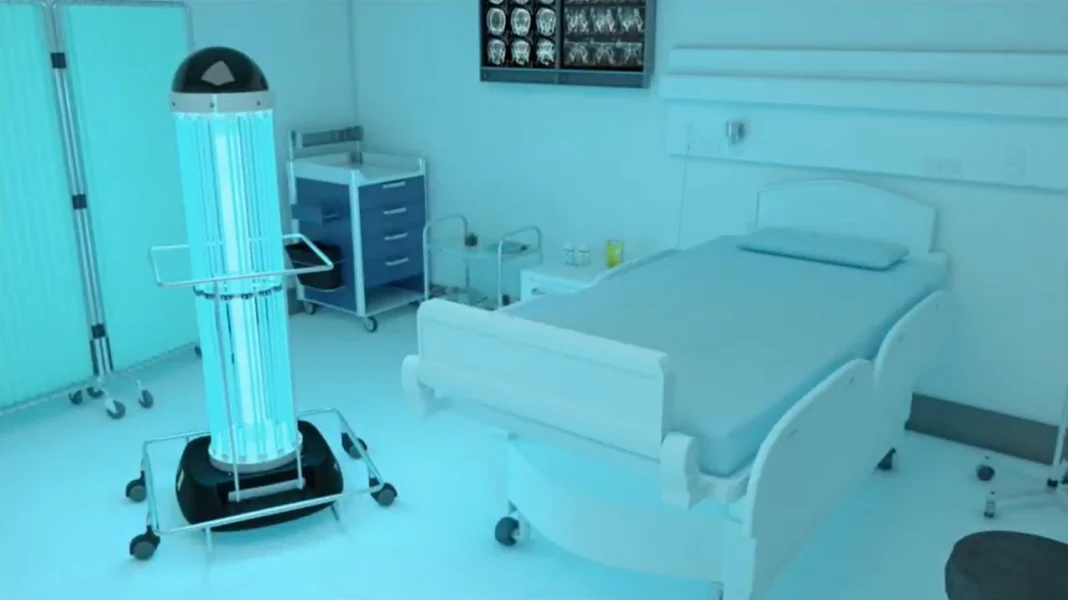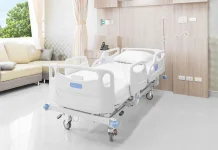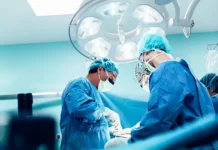Article provided courtesy of Tru-D® SmartUVC
San Juan Regional Medical Center in Farmington, New Mexico, is committed to providing patients and staff with the cleanest healthcare environment possible. Through a multifaceted approach, which includes the use of UV-C disinfection, the hospital has been able to reduce its infection rates as well as maximize its reimbursements.
A focus on C. diff
Clostridioides difficile (also known as C. diff) is a type of bacteria that causes diarrhea and colitis, an inflammation of the colon. According to the Centers for Disease Control and Prevention (CDC) , C. diff is estimated to cause nearly 500,000 illnesses in the US annually. C. diff is one of the hospital-acquired infections (HAIs) that the Centers for Medicare and Medicaid Services (CMS) considers when it comes to reducing harm to a patient. Per San Juan’s CMS Hospital-Acquired Conditions (HAC) report, C. diff represented one of the largest areas of opportunity to reduce infections at the facility.
Since 2017, San Juan Regional Medical Center has had significant improvements in its C. diff prevention process. The focuses for the project have included the following measures:
- Appropriate testing: Right specimen (Bristol 6-7), right patient (symptomatic with diarrhea), right timing (first three days of hospitalization), etc.;
- Environmental cleaning (quality of daily cleaning, high touch surfaces as well as discharge cleaning)
- Tru-D to follow each C. diff discharge cleaning
- Extensive nursing and provider education; and
- Isolation compliance by staff and visitors
Due to its robust efforts, San Juan Regional’s National Healthcare Safety Network (NHSN) Standardized Infection Ratio (SIR) rates have decreased dramatically since it began its process improvement in 2017.
San Juan Regional’s hospital-onset C. diff SIR for 2017 was 1.022. It decreased by 25% in 2018 to 0.760, and for the first half of 2019 its C. diff SIR has decreased another 59% to 0.31. From 2017 to 2018, San Juan Regional was able to avoid 14 C. diff cases through its process improvement efforts. According to San Juan Regional, the estimated cost of an individual hospital-onset C. diff infection is $11,285. This would translate to an estimated cost savings of $157,990. San Juan Regional also had further reductions in its C. diff cases in 2019, estimating an additional $56,425 in savings.
“Working with environmental services was vitally important to our process improvement, and Tru-D has assisted us to ensure that the patient rooms are safe for the next patient to use,” said Penny Hill, RN, MPH, CIC, infection prevention and employee health manager for San Juan Regional.
Additionally, the lower C. diff infection ratio has lowered San Juan’s overall CMS HAC score, which also reduces the hospital’s chances of incurring a penalty. “Healthcare is bimodal,” said Mike Malone, data scientist for quality systems for San Juan Regional. “As outcomes improve, so does reimbursement.”
Tru-D disinfection
Tru-D® SmartUVC is a portable UV-C disinfection robot that delivers one automated, measured dose of UV-C to consistently disinfect a room, resulting in the ability to document disinfection results after each Tru-D room treatment. Tru-D operates from one placement within the room, ensuring significant pathogen reduction in direct and shadowed areas and reducing the threat of human error in the disinfection process.
Tru-D supports its hospital partners in several ways, including the following:
- Custom implementation strategy
- Multidisciplinary support team
- Marketing and communications support and resources
- Tracking success of the UV-C disinfection program
- Training and educational materials
- Multiple purchase options
- Protection plans available for the life of the device
Increased number of operators leads to increased utilization
San Juan Regional began its Tru-D disinfection program in January 2014. Efforts in the beginning of the UV-C disinfection program were focused on running Tru-D in the operating room and isolation rooms. Initially, only management was trained to operate the device, which limited the facility in where it was able to run the robots and when it could be used.
“We weren’t being as efficient, so we weren’t hitting as many cycles,” stated Utahna Ortiz, manager of environmental services and laundry for San Juan Regional. Roughly a year into the program, San Juan Regional realized the need to train more people on the device to be able to better utilize its capabilities. The facility trained floor technicians who worked different shifts to ensure more around-the-clock use, targeting pathogens such as C. diff, MRSA, VRE, etc.
“Adding floor technicians to the list of people who could operate Tru-D helped to increase the usage, but we still weren’t where we needed to be to maximize its use and understand if we were really eliminating hospital-acquired infections,” Ortiz said.
San Juan Regional began to see its hospital-acquired rates decrease; however, nursing was also following new processes that may have been contributing factors. The next step was to cross-train everyone in the Environmental Services Department on how to operate Tru-D. Ortiz worked closely with the hospital’s Education Department to develop a HealthStream learning module that is a step-by-step process of how to run Tru-D.
“It’s great training that is now rolled out for all new Environmental Services employees. It also serves as a yearly competency for the housekeepers as a refresher to make sure everyone is using the program correctly,” Ortiz said.
Tracking utilization
With everyone cross-trained, San Juan Regional was still only running Tru-D “as needed,” and not on a daily schedule. Around this time, in 2017, the hospital adopted the Lean Daily Management approach to improve safety, quality and financial performance. This approach monitors performance and identifies key areas of improvement through key performance indicator (KPI) boards.
The Environmental Services Department started a KPI board, and in February 2018 began tracking Tru-D usage. The initial goal was six cycles per day, which the department was not routinely hitting. “By adding Tru-D to the KPI board and tracking it as a performance improvement goal, we were really able to focus on getting Tru-D out there in the hospital,” Ortiz said.
Staff members became very focused on ensuring goals were met each day. With buy-in from the team, everyone collaborated to make positive changes, which started with increasing the number of cycles.
“The Environmental Services Department has really welcomed Tru-D, and it’s now a part of everyone’s daily routine. Adding it to the KPI boards and making it a project everyone worked on together really helped to increase buy-in and ownership of the project,” said Ortiz.

Now Tru-D is also used in the emergency department, dialysis, the cardiac cath lab, endoscopy, the operating room, all isolation rooms, the ICU and the stepdown unit rooms.
“We are running it everywhere. There is not one clinical area we don’t hit,” Ortiz stated.
With the original goal of six cycles per day, San Juan Regional invested in a second Tru-D device, which has allowed the facility to triple its cycles, averaging 16 to 18 cycles per day with an average of 300 cycles per month.
“Our current KPI board goal is to disinfect 100% of our contact isolation rooms. Right now, we are at 95%. We were only hitting 65% of all contact isolations when we started the UV-C disinfection program,” she continued.
A welcome reception
San Juan Regional’s hospital staff and administration recognize the value Tru-D brings and has integrated the program into its emergency preparedness plan.






